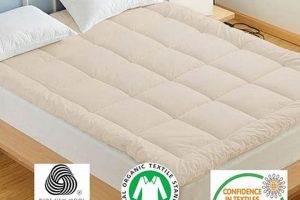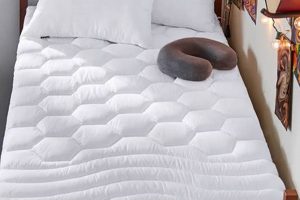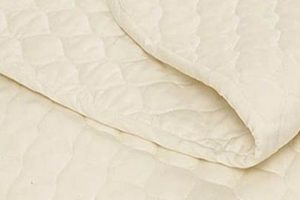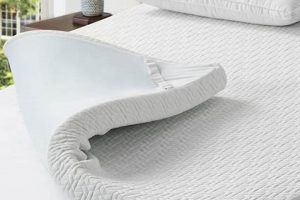The question of the optimal layering of sleep surface enhancements often arises. Understanding the purpose and properties of each component is key to achieving desired comfort and protection. A mattress topper is generally designed to alter the feel of the underlying mattress, adding softness, firmness, or pressure relief. A mattress pad, conversely, primarily functions to protect the mattress from stains, spills, and wear, and may offer a slight enhancement to comfort.
Proper layering affects both the lifespan of the mattress and the quality of sleep. Correct placement allows each layer to perform its intended function optimally. For instance, a barrier protecting against moisture is most effective when positioned closest to the potential source of spills. Furthermore, appropriate positioning helps maintain the integrity of both the topper and the pad, preventing premature wear and tear.
Therefore, the subsequent sections will delve into the recommended arrangement, considering factors such as material composition, desired outcome, and practical considerations. This detailed exploration will provide clarity regarding the most effective configuration for maximizing both comfort and mattress protection.
Layering Sleep Enhancements
Optimizing sleep comfort and mattress protection requires a strategic approach to layering enhancements. The following tips provide guidance on achieving the desired outcome while maintaining hygiene and extending the lifespan of sleep surfaces.
Tip 1: Prioritize Mattress Protection. A mattress protector should always be the first layer placed directly atop the mattress. This acts as a barrier against spills, dust mites, and allergens, safeguarding the mattress core.
Tip 2: Position the Topper for Comfort Enhancement. The mattress topper’s primary function is to alter the feel of the mattress. Its placement should be directly above the protector to maximize its impact on sleep comfort.
Tip 3: Consider the Pad’s Primary Role. A mattress pad, if used, typically offers a slight comfort boost and an additional layer of protection. Placement above the topper is generally recommended, although some prefer it beneath for a more subtle effect.
Tip 4: Assess Material Compatibility. The materials of each layer can influence overall comfort and breathability. Consider pairing breathable materials to prevent heat buildup and ensure adequate ventilation.
Tip 5: Account for Bedding Fit. Layering significantly increases the overall height of the sleep surface. Ensure that sheets and other bedding are appropriately sized to accommodate the added thickness.
Tip 6: Regularly Clean and Maintain. Each layer should be cleaned and maintained according to the manufacturer’s instructions. Regular cleaning prevents the buildup of allergens and helps prolong the lifespan of each component.
By adhering to these layering principles, individuals can optimize both sleep comfort and mattress protection, creating a more hygienic and restful sleep environment.
The final section of this discussion will cover any potential exceptions or specialized scenarios relevant to the optimal layering of sleep surface enhancements.
1. Protection
The role of protection in determining the optimal arrangement of sleep surface layers is paramount. Understanding how each component contributes to safeguarding the mattress and promoting hygiene is crucial for making informed decisions about layering.
- Mattress Protector as the First Line of Defense
A mattress protector’s primary function is to shield the mattress from spills, stains, allergens, and dust mites. By creating a barrier against these elements, the protector prevents them from penetrating the mattress core. Its placement directly on the mattress ensures maximum effectiveness in this regard. Consequently, other layers, such as toppers and pads, should be positioned above the protector to maintain its protective integrity.
- Topper Protection from Above
While the mattress protector safeguards the mattress, a mattress pad can offer a degree of protection to the topper itself. Placed atop the topper, the pad absorbs surface moisture and minor spills, extending the topper’s lifespan and preventing it from becoming soiled or damaged. This layering strategy addresses the overall hygiene of the sleep environment.
- Material Considerations and Breathability
The materials used in mattress protectors, toppers, and pads influence their ability to provide effective protection. Breathable materials, such as cotton or bamboo, allow for airflow and prevent the buildup of moisture, which can contribute to the growth of mold and mildew. Conversely, waterproof or water-resistant materials offer a more robust barrier against spills but may compromise breathability. Selection of materials should align with specific protection needs and desired comfort levels.
- Extending Mattress Longevity
Proper layering significantly contributes to the longevity of the mattress. By preventing spills and allergens from reaching the mattress core, the mattress protector preserves its integrity and extends its lifespan. This, in turn, reduces the need for premature mattress replacement, resulting in long-term cost savings.
In conclusion, the protective function of each layer dictates the recommended arrangement. The mattress protector acts as the foundation, directly shielding the mattress, while subsequent layers contribute to overall hygiene and the longevity of both the mattress and topper. The order of layering these products dictates the level of protection experienced and their individual lifespan.
2. Comfort
Comfort, in the context of mattress toppers and pads, refers to the subjective feeling of ease and relaxation experienced while resting on a sleep surface. Its attainment is directly influenced by the layering and properties of the various components used in bedding. Understanding how these layers interact is essential to optimizing sleep quality.
- Impact of Material Composition on Perceived Softness
The materials used in both the mattress topper and pad significantly influence the perceived softness or firmness of the sleep surface. Memory foam, for example, conforms to the body, offering pressure relief and a feeling of sinking into the mattress. Latex provides a more responsive and buoyant feel. The placement of these materials, and their interaction with a mattress pad, affects the overall level of comfort. A thicker, softer topper positioned directly beneath the sleeper will generally provide greater pressure relief than a thinner pad placed above it.
- Influence of Layering on Temperature Regulation
The order in which l
ayers are arranged also impacts temperature regulation. A breathable mattress pad placed atop a memory foam topper can help mitigate the heat retention often associated with memory foam. Conversely, a non-breathable pad may exacerbate heat buildup. Proper layering promotes airflow and prevents overheating, contributing to a more comfortable sleep environment. - Effect of Topper Thickness on Pressure Point Relief
Topper thickness directly affects the level of pressure point relief provided. A thicker topper conforms more closely to the body’s contours, distributing weight and reducing pressure on sensitive areas such as the shoulders and hips. The presence of a pad, whether above or below the topper, can subtly alter this effect. A pad placed above may slightly reduce the contouring effect, while a pad placed below may enhance it, depending on its material and thickness.
- Role of Pad Loft in Cushioning and Support
The loft, or thickness, of a mattress pad contributes to the overall cushioning and support of the sleep surface. A pad with higher loft provides a greater degree of plushness, while a thinner pad offers a more subtle comfort enhancement. The placement of the pad, whether above or below the topper, influences its impact on the overall feel. A thicker pad placed above the topper will generally provide a plusher feel, while a thinner pad placed below may offer a more supportive foundation.
Ultimately, comfort is a subjective experience, and the optimal layering of mattress toppers and pads depends on individual preferences. Experimentation with different arrangements may be necessary to achieve the desired level of support, pressure relief, and temperature regulation. Proper layering facilitates a more restorative and comfortable night’s sleep.
3. Hygiene
The issue of mattress topper and pad placement directly impacts the hygiene of the sleep environment. Improper layering can lead to accelerated accumulation of dust mites, allergens, and bodily fluids within the bedding. A mattress protector, positioned closest to the mattress, serves as the primary barrier against these contaminants. If a topper is placed beneath a pad lacking similar protective qualities, it becomes susceptible to absorbing sweat and other fluids, fostering an environment conducive to microbial growth. This can lead to unpleasant odors, allergic reactions, and a compromised sleep surface.
Consider a scenario where a memory foam topper is placed under a thin, non-waterproof mattress pad. Over time, perspiration and spills will seep through the pad and saturate the topper. Memory foam’s dense structure inhibits airflow, trapping moisture and creating a breeding ground for bacteria and mold. Conversely, placing the topper above a protective pad allows for easier cleaning and prevents the accumulation of contaminants within the topper itself. Regular washing of the pad and occasional cleaning of the topper contribute to maintaining a hygienic sleep environment. The impact on health and well-being of a cleaner sleep surface is significant.
In conclusion, prioritizing hygiene necessitates a strategic layering approach. A mattress protector beneath the topper and pad is essential. Regular cleaning of both the pad and topper is crucial for mitigating the buildup of allergens and contaminants. Adhering to these practices contributes to a healthier sleep environment and extends the lifespan of both the topper and the mattress. The practical significance of understanding this connection is evident in its direct impact on individual health and the longevity of bedding investments.
4. Longevity
The lifespan of both mattresses and sleep surface enhancements is directly influenced by their arrangement. Proper layering can significantly extend the usable life of these components, preserving their functionality and value. Conversely, incorrect placement can accelerate wear and tear, leading to premature degradation.
- Protection from Wear and Tear
A properly positioned mattress protector serves as the primary defense against friction and abrasion. When a mattress topper is placed directly on the mattress without a protector, it is subjected to constant rubbing against the sheets and bedding. This friction can cause the topper’s material to break down prematurely, reducing its support and comfort. Conversely, a pad placed atop the topper can absorb some of this wear, prolonging the topper’s lifespan. The presence of a protective barrier minimizes physical damage.
- Mitigation of Moisture Damage
Moisture accumulation is a significant threat to mattress and topper longevity. Sweat, spills, and humidity can penetrate the materials, leading to the growth of mold, mildew, and bacteria. These microorganisms degrade the structural integrity of the components and create an unsanitary sleep environment. A waterproof mattress protector placed directly on the mattress prevents moisture from reaching the underlying layers. Furthermore, breathable materials in the topper and pad facilitate airflow, reducing the risk of moisture buildup. Proper ventilation is essential for long-term preservation.
- Prevention of Compression and Deformation
Over time, mattresses and toppers can compress and deform under the weight of the sleeper. This compression reduces their support and comfort, leading to pressure points and discomfort. Proper layering can help distribute weight more evenly, minimizing the risk of localized compression. A supportive mattress pad placed above the topper can help maintain its shape and prevent sagging. Strategic layering delays the onset of deformation.
- Ease of Maintenance and Cleaning
Regular cleaning and maintenance are essential for extending the lifespan of mattresses and toppers. Proper layering facilitates these tasks. A removable and washable mattress pad protects the topper from surface stains and spills, reducing the need for more intensive cleaning. Furthermore, a clean and hygienic sleep environment minimizes the risk of dust mite infestations and allergen buildup, contributing to the overall longevity of the bedding. Simple maintenance has a significant impact.
Therefore, strategic layering, with emphasis on protection, ventilation, and ease of maintenance, is crucial for maximizing the longevity of mattresses and sleep surface enhancements. A well-considered arrangement safeguards the investment and ensures a comfortable and hygienic sleep environment for years to come. Careful consideration of these aspects is vital for prolonging their functional lifespan.
5. Material
The composition of both mattress toppers and mattress pads significantly dictates their optimal layering configuration. Material characteristics influence factors such as heat retention, breathability, and protective capabilities, directly impacting the sleeping experience and the longevity of the mattress itself. For instance, a memory foam topper, known for its conforming properties and potential for heat retention, benefits from a breathable mattress pad placed atop it. This pad, often composed of cotton or bamboo, facilitates air circulation, mitigating the heat retention associated with the foam and
contributing to a more comfortable sleep climate. Conversely, placing a less breathable material, such as a vinyl-backed pad, directly on top of a memory foam topper can exacerbate heat buildup, negating the potential benefits of the topper.
The protective qualities of the materials are also pertinent. A waterproof mattress protector, typically made of polyurethane or similar synthetic materials, is designed to prevent liquids and allergens from penetrating the mattress. As such, it is universally recommended to position this layer directly on the mattress itself, regardless of the subsequent layering of toppers and pads. Consider a scenario where a hypoallergenic wool topper is placed directly on the mattress, followed by a non-waterproof cotton pad. A spill would permeate both layers, potentially damaging the wool and rendering it a breeding ground for mold and mildew. Proper layering, with the waterproof protector closest to the mattress, would prevent such an occurrence. The choice of material directly correlates with the effectiveness of the sleep system.
In conclusion, material selection is a fundamental consideration in determining the appropriate layering arrangement. Understanding the inherent properties of each component be it memory foam’s heat retention, wool’s hypoallergenic nature, or polyurethane’s waterproof barrier is critical for optimizing both comfort and mattress protection. The effectiveness and lifespan of the sleep surface enhancements are inextricably linked to the materials used and their strategic placement. Disregarding material properties risks diminishing the benefits of these enhancements and potentially compromising the overall sleep environment. Thus, informed selection and layering based on material characteristics are essential for achieving a comfortable, hygienic, and durable sleep setup.
6. Thickness
The thickness of both mattress toppers and mattress pads plays a significant role in determining optimal layering configurations for sleep surfaces. Thickness influences the degree of comfort enhancement, support, and protection offered, thereby affecting the ideal placement of each component in relation to the mattress.
- Impact on Pressure Relief
Increased thickness in a mattress topper generally correlates with enhanced pressure relief. A thicker topper, typically exceeding three inches, provides a greater degree of contouring and weight distribution, reducing pressure on sensitive areas such as the hips and shoulders. Placing a thicker topper directly atop a mattress pad may negate some of its pressure-relieving benefits if the pad lacks sufficient density or support. The supporting mattress pad would ideally be denser, to allow the thicker topper to have maximal pressure relief for the sleeper.
- Influence on Support and Stability
The thickness of a mattress pad affects the overall stability of the sleep surface. A very thin pad, less than one inch thick, primarily serves a protective function, offering minimal enhancement to support. In contrast, a thicker pad can add a degree of firmness and stability, potentially counteracting excessive softness in the mattress or topper. Placement of a thin mattress topper under a very thick mattress pad might give the user a more sturdy experience.
- Effect on Heat Retention
The thickness of certain materials, such as memory foam, can influence heat retention. Thicker memory foam toppers tend to trap more heat than thinner alternatives. In such cases, a breathable mattress pad placed atop the topper can help mitigate heat buildup. Conversely, if a thicker, less breathable pad is placed above the topper, it could exacerbate heat retention, leading to discomfort.
- Implications for Bedding Fit
The combined thickness of the mattress, topper, and pad affects the fit of sheets and other bedding. Layering multiple thick components can significantly increase the overall height of the sleep surface, requiring deep-pocket sheets to ensure a secure and comfortable fit. Failure to account for this added thickness can result in ill-fitting bedding that compromises sleep quality.
In summary, the thickness of mattress toppers and pads is a critical consideration when determining optimal layering strategies. Understanding how thickness affects pressure relief, support, heat retention, and bedding fit allows for informed decisions that maximize comfort and extend the lifespan of sleep surface components. Adjustments to layering may be necessary based on the specific thicknesses and materials involved to achieve the desired outcome.
Frequently Asked Questions
This section addresses common inquiries and misconceptions surrounding the proper layering of mattress toppers and pads, providing clear and concise guidance for optimizing sleep comfort and mattress protection.
Question 1: What is the generally recommended order for layering a mattress, topper, and pad?
The commonly recommended order is as follows: mattress, mattress protector, mattress topper, and then mattress pad. This arrangement maximizes the topper’s comfort enhancement and protects the mattress from spills and allergens.
Question 2: Is a mattress protector always necessary, regardless of whether a topper or pad is used?
Yes, a mattress protector is highly recommended. It acts as a barrier against fluids, dust mites, and allergens, safeguarding the mattress core and extending its lifespan. It should be the first layer directly atop the mattress.
Question 3: Does the material composition of the topper and pad influence the layering arrangement?
Yes. For example, a memory foam topper may benefit from a breathable pad placed on top to mitigate heat retention. The properties of each material should be considered to optimize comfort and breathability.
Question 4: What if the mattress pad offers significant comfort enhancement; does this change the layering recommendation?
While the standard recommendation places the topper closer to the sleeper for maximum effect, experimentation is permissible. If the pad provides substantial comfort, placing it between the mattress and topper is an option, although the topper’s primary function may be somewhat diminished.
Question 5: How does the thickness of the topper and pad affect layering decisions?
Thicker toppers generally provide greater pressure relief, and their placement should prioritize this benefit. Thicker pads may influence the overall firmness of the sleep surface. The combined thickness also impacts the required depth of fitted sheets.
Question 6: Can the layering affect the warranty of the mattress or topper?
It is advisable to consult the warranty documentation for both the mattress and topper. Some warranties may specify certain layering requirements or prohibit the use of certain materials to maintain coverage. Adherence to these guidelines is critical.
Proper layering involves considering mattress protection, comfort preferences, material properties, and manufacturer recommendations. Experimentation may be necessary to achieve the optimal configuration for individual needs.
The following section will provide a summarized overview of the key points discussed regarding “Does Mattress Topper Go Under Mattress Pad”.
Conclusion
The exploration of the question “does mattress topper go under mattress pad” reveals that the optimal layering configuration prioritizes mattress protection and comfort
enhancement. Placement of a mattress protector directly on the mattress is universally recommended. Subsequently, the mattress topper should be positioned to maximize its intended comfort benefits, typically above the protector. While mattress pads can offer additional comfort or protection, their placement is secondary to the protector and topper’s primary functions, allowing for individual adjustment based on preference. These layering arrangement needs considering factors like lifespan, material, thickness and hygiene.
Effective sleep surface layering represents a commitment to both enhanced sleep quality and the longevity of bedding investments. By understanding the principles governing optimal arrangement, individuals can create a more hygienic, comfortable, and durable sleep environment, contributing to long-term well-being and minimizing the need for premature replacement of costly components. Consideration of these factors is essential for responsible management of sleep-related resources.







